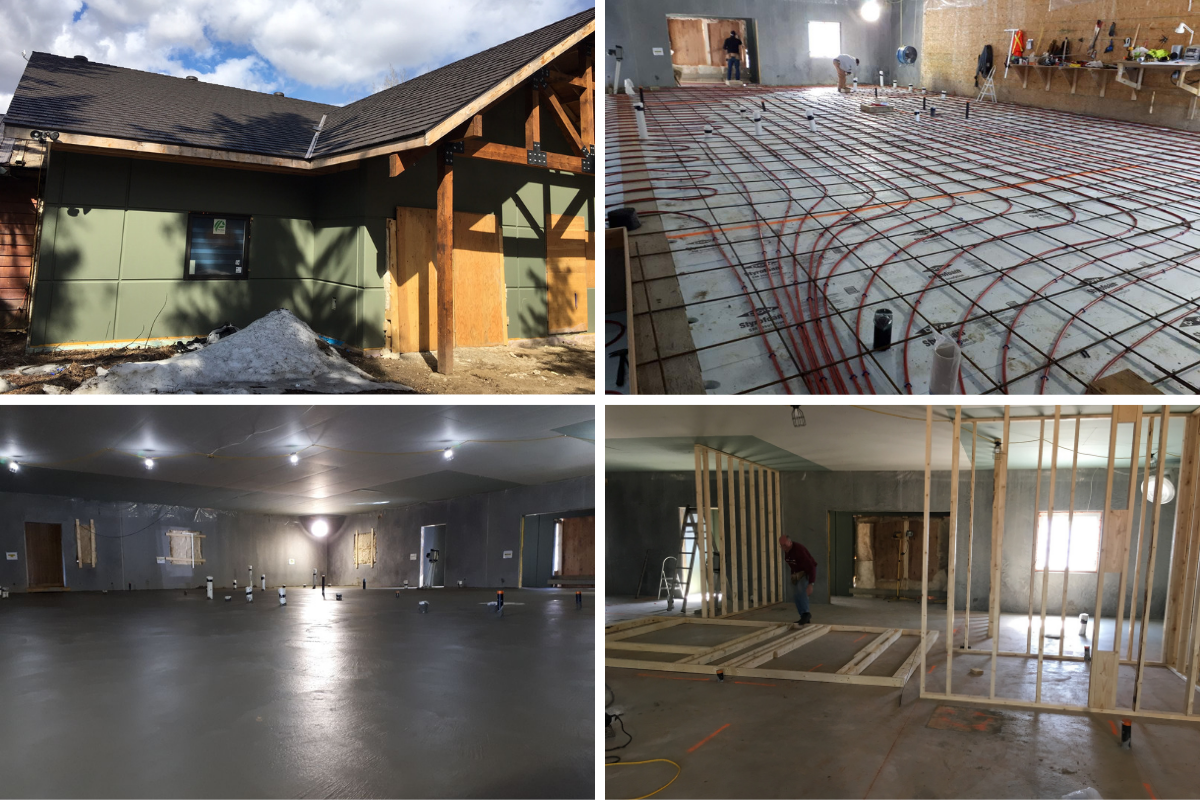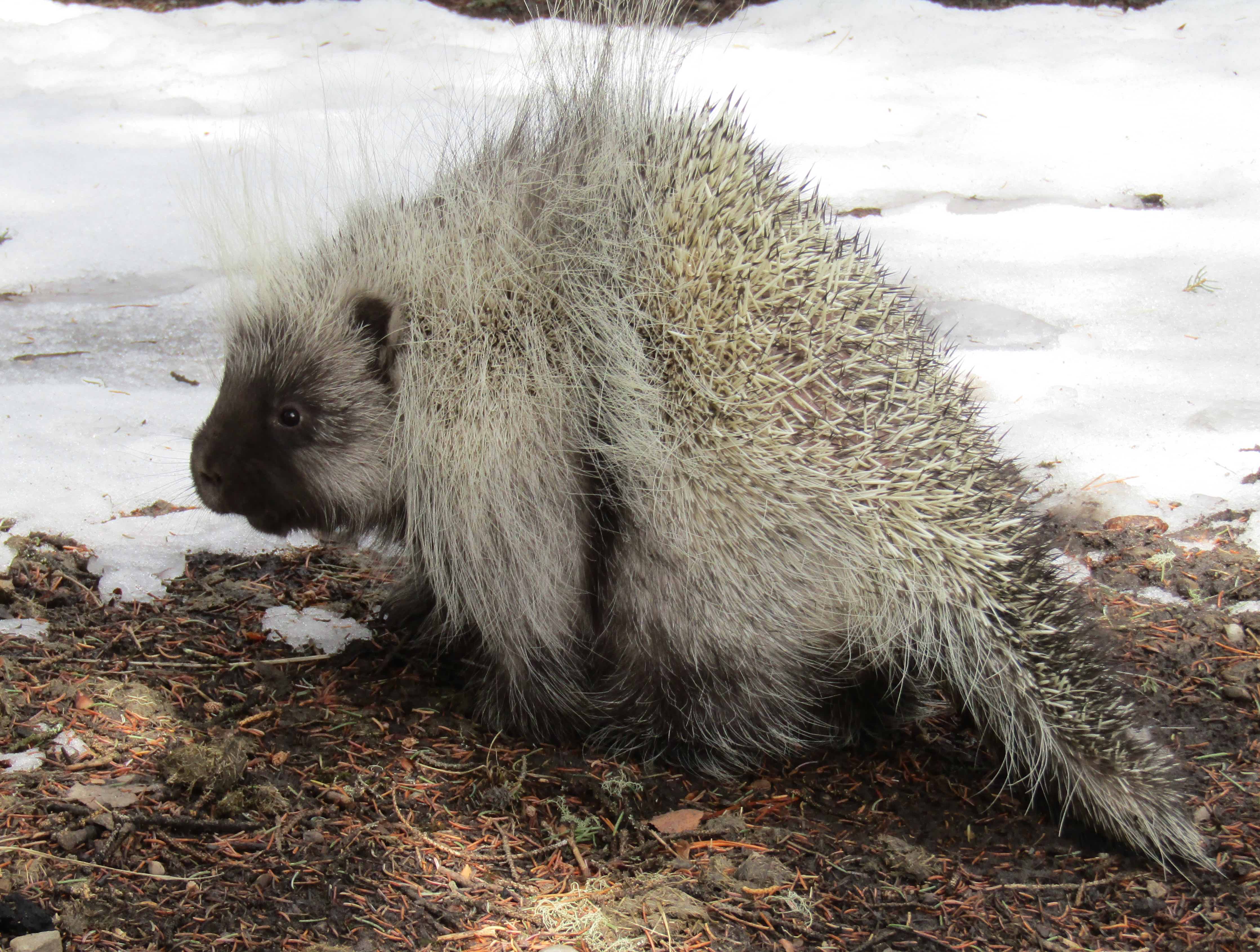About
Latest News
- News
This spring brought five moose calves to MRWC, all within a few days. Moose may be big animals but very easily succumb to a stress related illness called capture myopathy. All the calves were placed together in a quiet, natural enclosure but three did not survive due to the extreme stress they experienced before arriving.
Two however, thrived. We don’t name our patients but do reference their identification tags. "Big Blue" and "No Colour" drank the specially developed ungulate formula readily from the remote bottle station and spent hours browsing in the forested enclosure. Wild moose were occasionally seen visiting through the fence. The calves always panicked and ran when humans entered the area.
Early October is the time of year that two important things happen - local moose begin to gather on MRWC property and calves are weaned off milk. Once these things happen, it is time to open the enclosure doors and let the moose leave to join with others and become truly wild.
Big Blue and No Colour have been seen several times around MRWC's 493 acres, sometimes by themselves and other times in the company of as many as six other moose, but not once have they shown any interest in people. The staff did a great job following protocols and we smile each time we see the calves doing what moose are meant to do.
- News
Every fall MRWC receives patients that arrive late in the season, recover, but miss their chance of migration and have to overwinter, even though they are healthy and releasable. In past years, MRWC has cared for such things as Sandhill Cranes, ducks, or Great Blue Herons. This year is no different. We are currently housing a Rose-breasted Grosbeak, Cedar Waxwing, American Robin, juvenile Bald Eagle, Red-tailed Hawks and a Cormorant.
Many of the species we house are relatively simple to care for but some, such as the Cormorant, require a bit more attention. Our Cormorant cannot be kept in our pond with the other waterfowl due to his easily stressed personality and the way he needs to feed. Instead, he is kept in a quiet, private room with a large rubber container filled with water. Clean water and fish are put into the container each day an he spends much of his time perched on the edge, dipping fish. We are very grateful to Smoky Trout Farm for the donation of 250 pounds of lovely trout to keep him fed.
Most birds that are overwintered leave Alberta and cross borders during migration and with current regulations this makes it impossible to send these patients over those borders to their normal wintering grounds. Our Cormorant, however, can spend his winter in the lower mainland of British Columbia. This may seem easy, but there are still borders to cross. MRWC has begun the process to put export and import permits into place and hope we will not have to keep this guy for the next five months. I’m sure he feels the same.
- News
Alberta has 6 types of Grebes ranging from the tiny Pied-billed to the larger and very vocal, Western Grebe. These birds are built very much like loons in that their legs are placed at the end of their body near the tail leaving them unable to stand and walk like other birds. They need a long run on water to be able to take off taking about 20 steps per second. This leaves grebes at an advantage if they find themselves on land. We often see “grounded” grebes on roads after a rainstorm. Wet pavement can confuse them into thinking it is a river, so they land on a very hard surface and are grounded, rarely doing any major damage.
We see most of these grounded grebes in the fall and spring as grebes are migrating. People often mistake these birds as ducks and can’t understand why they aren’t flying. This fall if you see a bird with a fat body, long beak, and possibly red eyes, on the ground that isn’t flying, text us a picture for ID and we’ll help direct you as to what to do.
- News
After 16 years of handling the majority of the 150 education programs we do each year, Otis the Owl finally has a little help. Olive the Owl has joined our team after being orphaned this spring. She is not imprinted on people but has been socialized in order to be comfortable in her new role. She is still in training but has now attended several programs, wowing her audiences. Olive is fun and curious and will play a big part in connecting people to nature.
- News
Staff at the Centre recently had a pleasant surprise when checking on the condition of a Big Brown Bat in recovery. As the enclosure was opened and staff reached for the recovering female bat, it was noticed that she had a rather large baby wrapped around her chest! The baby is surprisingly big weighing in at 3 grams. The normal weight of an adult Big Brown Bat is 17 grams. That equates to a human giving birth to about a 30lb baby!
How did this happen? Well, bats are one of approximately 100 species in the world that have what is known as delayed implantation. The bat is bred in the fall but holds the embryo in a dormant state until conditions are good and baby can grow. Mother and baby are doing well but the next challenge will be what to do with the baby if mother doesn’t fly again. We are consulting with leading bat specialists to develop a plan.
- News
For the past two springs we have been called to help the Parkland School in Red Deer as the snake hibernaculum (the place where snakes gather to spend the winter) on their property has numerous garter snakes awakening and making their way across the school grounds. The school is located a short distance from the Kerry Wood Nature Centre so the snakes are transported to the wetland and forest surrounding the Centre to spend their summer. They would have made their way there anyway but taking them away from the activity of a school ground is safer for both animals and people. This year, as Gwen was moving the snakes, she noticed one that had some spine issue which limited her mobility. It was decided to take it back for some care and recovery. One June 22 that recovering garter snake gave birth to 22 healthy, little garter snakes! Although the female still cannot be released, after consultation with Alberta’s snake expert, the little snakes were released at the Kerry Wood Nature Centre where the mom would have given birth if not injured.
70% of the world’s snakes lay eggs while the others give birth to live young. Live-birthing, or viviparous snakes, tend to live in colder climates. Those who lay eggs require warmer climates to help incubate.
- News
At the end of April 2019, and again the middle of June 2019 we had thieves break in to our building. The first time they got away with more than $10,000 worth of tools and supplies and even took the keys to all our vehicles. The second time they came in during daylight hours, while staff was still working onsite, but didn't steal nearly as much. A huge thanks goes out to the supporters who helped us during this frustrating time.
- News
Red Fox move into towns and cities to take advantage of abundant food sources such as jackrabbits, ground squirrels, or other small mammals. They can be deterred from living under sheds or other structures with lights, coyote or wolf urine (purchased at outdoor supply stores), or a radio playing to give the illusion of people always being there.
- News
Northern Flickers can be seen in Alberta with many even staying all winter to feed on fruit and seeds at backyard feeders. MRWC sees several each year in the hospital, often hit by vehicles due to their habit of feeding in ditches.
Flickers are a type of woodpecker that feed mainly on insects on the ground. Ants are a particular favorite. They are a larger, brown bird with a spotted belly and a black bib. They can be found in two varieties - red or yellow shafted, meaning the undersides of the wings will be yellow or red. In both varieties the male will have a "mustache" but it will be black in the yellow shafted and red in the red shafted. A flash of the large white rump as they fly off is a good field mark to identify the bird.
Flickers are cavity nesters and both male and female work together to excavate holes in dead trees and raise the young. The nests do not have any bedding as once the young are over 2 weeks old they simply cling to the side of the hole and wait for parents to put their heads in to feed. Average clutch is 5-8 eggs.
The population of Flickers is considered in steep decline and has decreased by over 49% since 1966. They are most vulnerable to free roaming cats, pesticides, and vehicles. You can help by eliminating these dangers and by putting up nest boxes if you have appropriate habitat with a mix of open fields and forest.
- News
We received a report of two skunks on the riverbank in Red Deer - one stuck and the other dead. Staff was sent and the healthy one was able to get free and ran away while the ”dead” one was found to still be breathing. She was scooped up and faithfully administered heat and treatment. By the evening she was up and interested in food. The next day she had made a full recovery!
It is likely that these skunks were brought to the river to be drowned. Unfortunately, some see this as the only solution to a skunk "problem". We encourage anyone struggling with wildlife challenges to contact us. Our
- News
After years of not being a part of the parade in Red Deer, we were very happy to celebrate and join in on all the fun once again. We have used the same skit during the walk since we first took part 30 years ago, and it's still just as popular. A huge thanks to our summer interns for putting on a great show!
- News
We are very excited to have a small reception room open to the public the first part of August!
- News
With the recent change to our intern program, we now have seven fun and eager young volunteers working from May through August/September.
- News
We are very excited to be a part of Alberta's Highway Clean Up Campaign this May and we need volunteers! You can help beautify our roadways and raise money for MRWC by giving a few hours on either May 4 or 11, weather permitting, hopefully somewhere along Highway 54, west of Innisfail. Participants must be at least 9 years of age. Sign up here (this is a public form where others may see your name and phone number) or
- News
If you don't want skunks in your yard, don't invite them! Being proactive and keeping skunks out of your yard is a better solution than trying to remove them after they have arrived. Did you know that trapping and relocating can actually make the problem worse? Taking away a skunk without removing what brought it in will only lead to another taking its place. Altering the population can lead to females having bigger litters to compensate.
- News
With the recent donation of $70,000 by Ruth Bower we have been able to install the heat pipes, rough-in plumbing, and pour the concrete floor. The shingles were installed and the windows placed. The freezer room has just gone in and the doors are on their way. The indoor wall construction began this week and it's really starting to feel like a building now. March was a very busy and exhausting month as dedicated and cherished volunteers worked to prepare the areas for the professional trades. Thanks to CB Construction, Pidherney's, Cobijar Consulting, Harriman Lumber, and Hurricane Truck & Bobcat for their generous price reductions. Thanks to DJ Will Construction for their ongoing support.
We have just received word that Ruth & Dorothy Bower have decided to contribute once again to the project by giving a further $100,000 to match the funds that we have applied for from the Community Facility Enhancement Program! We'll receive word in July for the final $125,000 to complete the hospital project.

- News
Olds College has implemented a new program, "Stream Your Dream", which sees students explore other areas of specialty animal care besides the usual vet clinics. These areas can include onsite veterinary specialties to horse ranches and wildlife rehab centres. This spring’s students, Alyson and Jessica, spent the first week of April looking at our information and asking questions to better understand our work.
- News
With much of our focus being on the rebuild of the wildlife hospital, this the raptor flight enclosure project has fallen by the wayside. We are now resurrecting it as our current cages are close to being unusable. Without proper flight pens we will not be able to take raptors in for rehabilitation.
- News
Porcupine tend to be one of the misunderstood animals that live around Alberta, but are truly one of our staff favourites. Numerous urban myths surround them, leaving people in fear of these quiet, gentle creatures.
Porcupine are Canada’s second largest rodent, with the beaver being the largest. We most often think of rodents, like mice, breeding often and having large litters but interestingly porcupine multiply very differently. Females breed in a rather vocal, interesting breeding dance and are then pregnant for 7 months and deliver only one “porcupette”. Twins are considered very rare. These adorable little babies are fully developed with teeth and quills at birth. They are not carefully nurtured by the female and are often weaned by the age of 10 days. They spend the summer following the female and learning from her behaviour.
They are covered in 30,000 hollow, modified hairs called quills that are their only protection from predators. They can’t shoot these quills but do have a flat, strong tail covered in the largest of the quills that can strike an attacker with lightning speed, giving the illusion that they shot the quills. They are not filled with air so it does not help to cut a quill before pulling it from your dog’s face; it really makes the quill harder to grip and pull out.
Porcupines love to eat the inner bark of trees, dandelions, and other vegetation. If they are “loving” your plants or trees you can use a spray that can be purchased at any garden store, Bobbex, to protect your yard. This spray needs only to be reapplied every three months so is very long lasting and effective for porcupine and others like hare, deer, and voles.
Porcupine are hunted by such predators as Coyote, Cougar, Bear, Wolf, Fishers, and Great Horned Owls.

- News
April 7-13 is designated as National Wildlife Week this year. This year the Canadian Wildlife Federation is asking you to #DoMoreForWildlife and to create a healthier world for all living beings and spaces.
Celebrate Earth Day on April 22. When we come together, the impact can be monumental.


